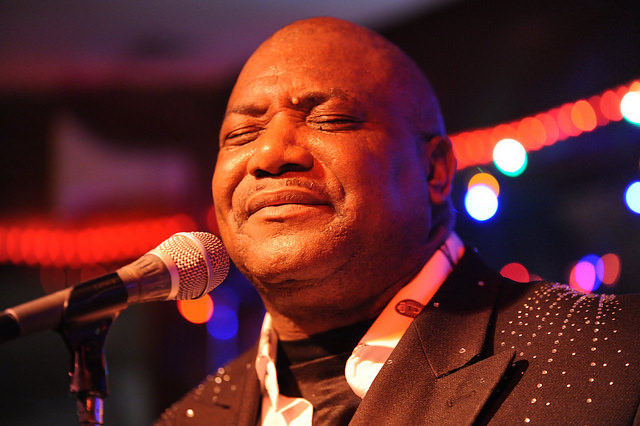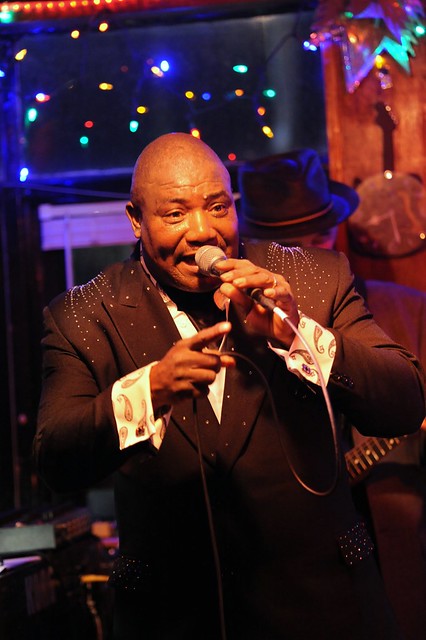
Gene Jackson: Out of the box with 1963
By Bob Baugh
Gene Jackson will remember night of March 10, 2017 for the rest of his life. It is the date of his Beale on Broadway release party for his first album, 1963. It has been a long road for the well-known local soul singer but the wait has been worth it.
Gene, a 1979 Soldan graduate, started life in the Pruitt-Igoe projects with his mother, Mary Coleman, who loved to sing and did freelance work with Ike and Tina Turner, The Shirelles and others. She provided the R&B and soul influence while encouraging his interest in music by signing papers when he was 15 to enable him to play with bands. Back in those days he says he was "too shy to sing on stage," so he stuck to flute, congas and drums and limited his vocals to the Mt. Gideon church choir.
As a teen, Gene began a nine-year gig with Doc Terry, the house band at the Mary Moonlight Lounge on ML King, playing flute and congas while his friend Skeet Rodgers played the drums. Rodgers (Inner City Blues Band) eventually stepped out front as a singer which inspired Gene to did the same. He joined Power Play as a pop singer thirty years ago and added blues/soul to his catalogue when he joined Soul Reunion sixteen years ago. A decade ago, after losing his day job, he decided to make a go of it as a full time singer.
The only other time Gene recorded it was a music industry rip off story. In 1989 he recorded two singles. One, "The Night I Fell in Love," became a smash hit in England but he didn't know it. When he found out he discovered his name was spelled Jean and another person's picture was on the cover. He and his attorney daughter, Venus, are still chasing the royalties that were stolen from him.
It was trust and respect that brought Gene to Paul Niehaus and his Blue Lotus Studios. He was impressed with Niehaus and Kevin O'Connor's work as co-producers of Roland Johnson's 2016 CD, Imagine This, which was first original music release of Roland's career. Like Johnson, Jackson had covered others work for years but hearing that release convinced him it was time to do one of his own.
When Gene called Paul to see if they could do something similar his response came easily: "I said yes because I love his voice and emotional singing style." Once they began working together "it became clear," Gene says, "they were meant to make music together. He reminds me of my younger self." Their five-month effort with co-producer Kevin O'Connor, resulted in a deeply personal album about love, desire, marriage, joy, poverty and death that draws upon Jackson's life experience.
The 10 cuts selected for on 1963 came from the 15 they actually wrote. While soul flows through the album, Gene and Paul describe it as a "bit out of the box." Jackson says it has "the feel of the early movement 60's through the roughness of the 70's with each song in a different key." And, he loves the "icing on the cake" that Paul adds to the songs at the end of their creative process. Paul agrees citing one of the out of the box elements: "Some of the tracks have 'wall-of-sound' elements in their production style, which was really fun to make."
Their creative process begins by finding a groove/a feel for a song. From there Paul says, "I would write a song form to it, to get all the phrases and sections. Then I added guitar and keyboard parts, and bounce out a rough mix." Gene would then take the music and work out the melody and lyrics. There was plenty of give and take between Jackson, Niehaus and O'Connor. Jackson co-wrote seven of the songs with Niehaus; O'Connor, who played drums and handled the string arrangements, joined them in writing the other three.
In the case of "Ain't No Way," which also appeared on the new St. Louis Blues Society 16 in 16, Jackson had a melody in his head and Paul and Kevin turned into music. On "Son" it only took Paul playing a few chords for Gene to tell him, "I have it, the music speaks to me. I can write the words easily."
Other songs weren't as easy. Both say "Rag Doll," even thought it was the first song written, and "Voodoo Girl" were the toughest and last to be finished. The creole flavor of the latter "was a real change of beat and rhythm," Jackson says, "I had to get online and do a lot of research to understand what it is so I could find the right words."
The traces of Stax and Motown run through 1963. Listening to the opening chords on "That's Why I Love You," "1963," "Only God Can Help Us," "You're Gonna Get Hurt," and "Married at the Station" will make you think of other hits from those labels. The opening of "Love at First Sight" even echoes the Beatles. The icing on the cake Gene loves here is the "lushness and change of direction" that Paul achieves with the final elements he incorporates such as a conga drum, violins or orchestration.
Gene and Paul are pleased with the outcome. Paul is excited because "this album has one foot rooted in classic 60s soul and another reaching forward into the future." Gene says the message "is about life and I hope people get enjoyment from what I wrote." As a guy who grew up in Motown in the '60s, all I can say after listening to 1963 is well done, brothers, well done.
Click below for Bob Baugh's photos from the album release party.



